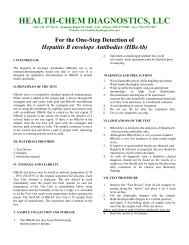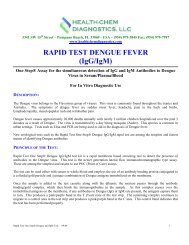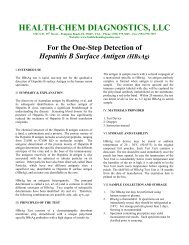Ten Parameter Multistrip - Health-Chem Diagnostics
Ten Parameter Multistrip - Health-Chem Diagnostics
Ten Parameter Multistrip - Health-Chem Diagnostics
Create successful ePaper yourself
Turn your PDF publications into a flip-book with our unique Google optimized e-Paper software.
HEALTH-CHEM DIAGNOSTICS, LLC<br />
3341 S.W. 15 th Street – Pompano Beach, FL 33069 - USA – Phone: (954) 979-3845 – Fax: (954) 979-7997 Website:<br />
ww.healthchemdiagnostics.com<br />
URICHECK<br />
<strong>Ten</strong> <strong>Parameter</strong> <strong>Multistrip</strong>: pH, Protein, Glucose, Ketones, Bilirubin, Blood,<br />
Nitrite, Urobilinogen, Specific gravity, Leucocyte esterase (smaller<br />
combinations also available).<br />
INTRODUCTION<br />
The UriCheck urine testing device consists of a firm plastic film to which several separate<br />
reagent patches are affixed. The list below outlines the particular parameters used for each<br />
specific UriCheck:<br />
UriCheck 1<br />
UriCheck 2<br />
UriCheck 2S<br />
UriCheck 3<br />
UriCheck 3L<br />
UriCheck 4L<br />
UriCheck 5<br />
UriCheck 5N<br />
UriCheck 9L<br />
UriCheck 10L<br />
Glucose<br />
Ketone, Glucose<br />
Protein, Glucose<br />
Protein, Blood, Glucose<br />
Leucocytes, Protein, Blood, Glucose<br />
Leucocytes, Nitrite, Protein, Blood, Glucose<br />
Protein, pH, Blood, Ketone, Glucose<br />
Nitrite, Protein, pH, Blood, Ketone, Glucose<br />
Leucocytes, Nitrite, Urobilinogen, Protein, pH,<br />
Blood, Ketone Bilirubin, Glucose<br />
Leucocytes, Nitrite, Urobilinogen, Protein, pH,<br />
Blood, Specific Gravity, Ketone, Bilirubin,<br />
Glucose<br />
OPERATING INSTRUCTIONS<br />
• Ensure the urine is less than 4 hours old and at room temperature.<br />
• Check the expiry date on the strip can.<br />
• Remove, one strip at a time and replace the lid immediately.<br />
• Do not touch the test patch - hold by the handle.<br />
• Dip the test strip into fresh urine for approximately 2 seconds.<br />
• Remove excess urine by briefly blotting the side of the strip on absorbent tissue.<br />
• After 30-60 seconds, compare the test strip with the colour scale.<br />
1
• Colour changes after 2 minutes are of no significance.<br />
STORING INSTRUCTIONS<br />
STRIPS<br />
• Store the can in a dry place below 30ºC.<br />
• Replace the cap immediately after use.<br />
• Check the expiry date.<br />
URINE<br />
• Urine can be stored up to 4 hours in the refrigerator.<br />
• After 4 hours the urine might produce false results.<br />
• Allow the urine to warm to room temperature before use.<br />
PARAMETERS<br />
NITRITE<br />
<strong>Chem</strong>ical Principle: Gram-negative bacteria in the urine are able to reduce dietary nitrate to<br />
nitrite. The test is based on the principle of the Greiss reagent whereby the nitrite forms a<br />
diazonium compound with the ą-Naphthylamine in an acidic medium.<br />
This results in a colour change from cream to pink.<br />
Reagents: ą-Naphthylamine and non-reactive ingredients.<br />
Sensitivity: 0,06 - 0,1 mg/dL Nitrite ion.<br />
Interfering Substances: Ascorbic Acid, Specific Gravity.<br />
UROBILINOGEN<br />
<strong>Chem</strong>ical Principle: p-(dimethylamino) benzaldehyde and a colour enhancer react with the<br />
urobilinogen at an acidic pH to produce pink/red colours.<br />
Reagents: p-(dimethylamino) benzaldehyde, malonyl urea, buffer and non-reactive ingredients.<br />
Sensitivity: 0,15 - 0,4 mg/dL Urobilinogen.<br />
Interfering Substances: p-Aminosalicylic acid and sulfonamides p-Aminobenzoic acid,<br />
Forutin and temperature.<br />
PROTEIN<br />
<strong>Chem</strong>ical Principle: The test is based on the ‘Protein-error’ of the indicator. The protein in the<br />
urine combines with the blue divalent anionic form of the indicator. This results in the<br />
dissociation of the yellow monovalent anion into the blue divalent anon. Although the test patch<br />
is buffered to a constant pH, a colour change from yellow through green to blue will occur in the<br />
presence of protein.<br />
Reagents: Tetrabromophenolphthalein, bromophenol blue, buffer and non-reactive ingredients.<br />
Sensitivity: 15-30 mg/dL albumin.<br />
Interfering Substances: Quatemary ammonium compounds and chlorhexidine, Alkaline urines.<br />
2
pH<br />
<strong>Chem</strong>ical Principle: A dual indicator system allows for a colour change from orange, through<br />
green to blue over a pH range.<br />
Reagents: Methyl red, bromothymol blue and buffer.<br />
Sensitivity: pH 5,0 - 8,5.<br />
Interfering Substances: No known substances.<br />
BLOOD<br />
<strong>Chem</strong>ical Principle: Pseudoperoxidative activities of the haemoglobin and myoglobin<br />
components of blood are responsible for the catalytic oxidation of the indicator, in the presence<br />
of the organic hyperoxide. This results in a colour change from yellow through green to blue.<br />
Whole red blood cells (RBC) produce a mottled colour while haemoglobin produces a uniform<br />
colour<br />
Reagents: 0-Toluidine, quinoline sulphate, cumene hydroperoxide, buffer and non-reactive<br />
ingredients.<br />
Sensitivity: 0,015 - 0,062 mg/dL haemoglobin.<br />
Interfering Substances: Oxidising and peroxidising agents, microbial peroxidase, temperature,<br />
Captopril®.<br />
KETONE<br />
<strong>Chem</strong>ical Principle: Acetoacetic Acid (the physiological ketone) reacts with Sodium<br />
Nitroprusside to produce a pink or mauve colour.<br />
Reagents: Sodium nitroprusside and buffer.<br />
Sensitivity: 5-10 mg/dL Acetoacetic Acid.<br />
Interfering Substances: Mesna- and Sulfhydryl groups, exposure to moisture.<br />
BILIRUBIN<br />
<strong>Chem</strong>ical Principle: Diazotized dichloroaniline couples with the bilirubin, in an acidic medium,<br />
to produce tan to brown colours.<br />
Reagents: 2, 4-Dichloroaniline, l,5-naphthalenedisulfonic acid, sodium nitrite.<br />
Sensitivity: 0,4-0,8 mg/dL bilirubin.<br />
Interfering Substances: Indoxyl sulfate, Ascorbic acid and metabolites of Etodolac.<br />
GLUCOSE<br />
<strong>Chem</strong>ical Principle: The test is based on the glucose oxidase/peroxidase chromogen reaction.<br />
The glucose oxidase oxidises the glucose to form hydrogen peroxide. The perioxidase then<br />
catalyses the hydrogen peroxide with a potassium iodide chromogen. The extent to which the<br />
chromogen is oxidised determines the colour which is produced - ranging from green to brown.<br />
Reagents: Glucose oxidase, peroxidase, potassium iodide, buffer and non-reactive ingredients.<br />
Sensitivity: 75-125 mg/dL Glucose.<br />
Interfering Substances: Ketone bodies, ascorbic acid, gentistic acid, specific gravity and<br />
temperature.<br />
3
LEUCOCYTES<br />
<strong>Chem</strong>ical Principle: Granulocyte esterases are contained within the leucocytes bodies<br />
(white blood cells). These enzymes cleave the indoxyl ester in the patch. The liberated<br />
indoxyl portion then reacts with the diazonium salt to give the colour formation.<br />
Reagents: Derivatized pyrrole amino acid ester, Diazonium salt, Buffer.<br />
Sensitivity: 5 - 15 cells/μL in clinical urine.<br />
Interfering Substances: Vaginal discharge, intensely coloured urine, high glucose, protein and<br />
specific gravity values.<br />
SPECIFIC GRAVITY<br />
<strong>Chem</strong>ical Principle: Cations in the urine induce the release of protons from a complexing agent<br />
in the patch. This results in a non pH dependent colour change in the bromothymol blue indicator<br />
over the range of yellow through green to blue.<br />
Reagents: Bromothymol Blue indicator, Buffer.<br />
Sensitivity: 1,000 - 1,030.<br />
Interfering Substances: High protein and ketone values. Highly buffered alkaline urine.<br />
Manufactured by:<br />
HEALTH-CHEM DIAGNOSTICS LLC,<br />
POMPANO BEACH, FLORIDA<br />
Website: www.healthchemdiagnostics.com<br />
4






